What to Do With Leftover Vegetables
Don't let those leftover vegetables go to waste! You've got plenty of delicious options to transform them into new meals. Try incorporating them into a fried rice dish, blending them into a hearty soup, or stir-frying them with your favorite protein. Leftover veggies are perfect for frittatas and quiches, adding both flavor and nutrition. Roasting is another great way to bring out their natural sweetness. For a twist, use them in pasta dishes or risottos, or mash them with potatoes for a classic Bubble and Squeak. You can even turn them into crispy fritters. The possibilities are endless when you know how to repurpose your leftovers creatively.
This post may contain affiliate links. If you make a purchase through these links, I may earn a commission at no additional cost to you. Additionally, portions of this post may be generated using artificial intelligence (AI) technology. While we strive for accuracy, please be aware that AI-generated content may not always be perfect and should be fact-checked when necessary.
The Spatula Scoops
- Transform leftover vegetables into a flavorful fried rice dish by stir-frying with garlic, ginger, and day-old rice.
- Create a hearty soup by sautéing aromatics, adding leftover vegetables, and pureeing for a creamy texture.
- Incorporate leftover vegetables into a frittata or quiche for a versatile and nutrient-rich meal.
- Roast chopped leftover vegetables with oil and seasonings for a simple and delicious side dish.
- Use leftover vegetables to enhance pasta dishes or risottos, adding flavor, texture, and nutritional value.
Fried Rice Remix
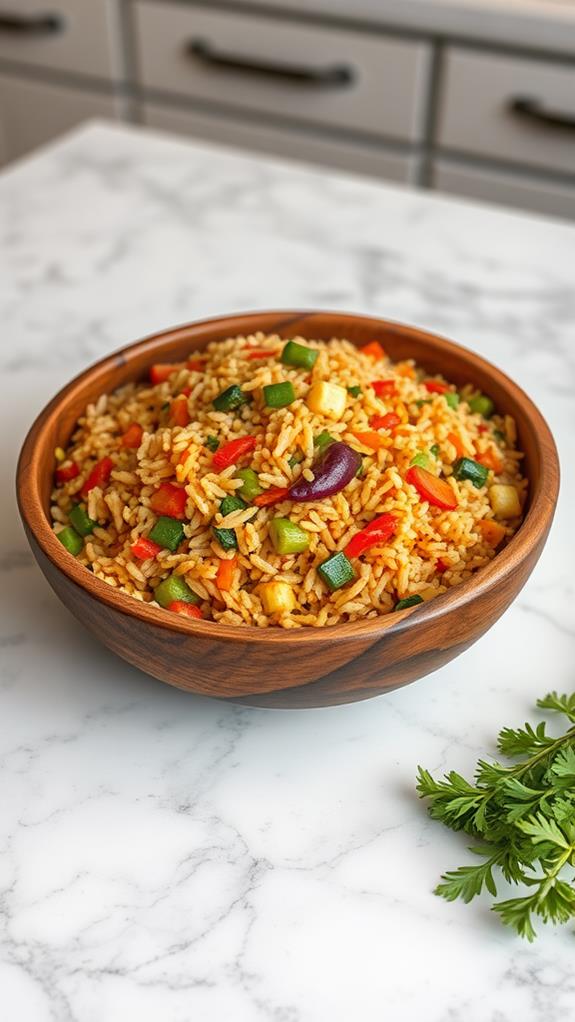
Got a hodgepodge of leftover veggies? Don't let them go to waste! Transform them into a delicious fried rice remix that'll have you looking forward to leftovers. Start by heating up a frying pan with a bit of oil. While it's warming, chop your leftover vegetables into bite-sized pieces. Once the pan is hot, add some minced garlic and ginger for a flavor boost. For a touch of sweetness and to help caramelize the vegetables, you can add a small amount of light corn syrup, which will also contribute to a glossy finish.
Next, toss in your leftover veggies and stir-fry them until they're heated through. Push the vegetables to one side of the pan and crack an egg into the empty space. Scramble it quickly, then mix it with the veggies. Now, add your day-old rice – it's perfect for soaking up flavors without getting mushy. Stir everything together, making sure the rice is evenly coated with the vegetable mixture.
Season your creation with soy sauce, a dash of sesame oil, and any other spices you enjoy. Keep stirring until everything is hot and well-combined. This versatile dish adapts to whatever leftovers you have on hand, making it a great way to reduce food waste and create a satisfying meal.
Soup It Up
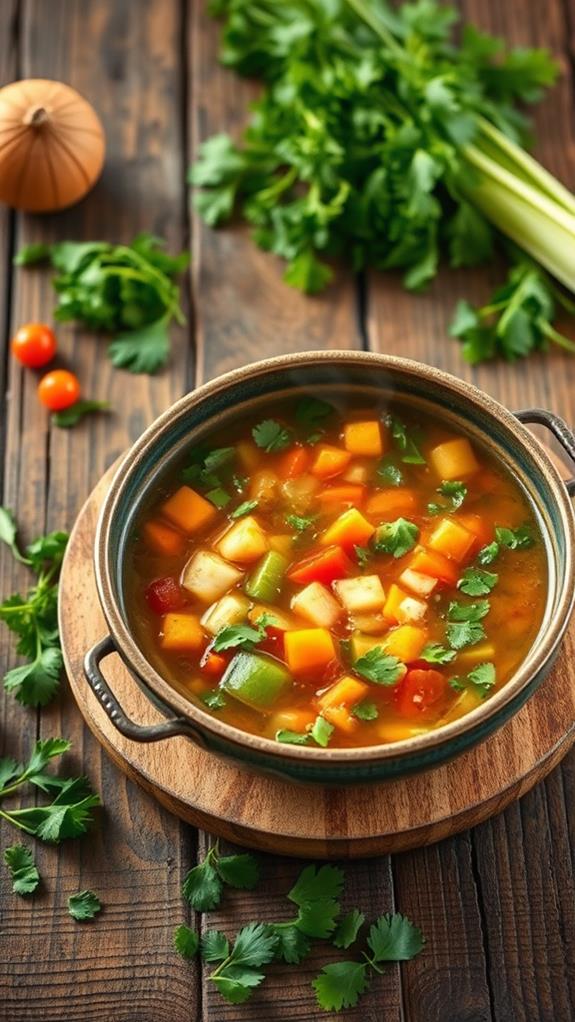
Another fantastic way to repurpose leftover vegetables is by turning them into a hearty soup. This method allows you to Use Leftover produce efficiently while creating a warming, nutritious meal. To Make your soup, start by sautéing aromatics like onions and garlic in a large pot. Then, simply add your leftover veggies, chopped into bite-sized pieces, along with broth or water. For a silky smooth texture, consider using a stainless steel food mill to puree your vegetables, which can handle hot ingredients without the need for cooling. This versatile tool is perfect for creating various textures in your soups and sauces.
The beauty of soup-making lies in its versatility. You can combine various vegetables, adjusting the flavors to suit your taste. For a creamy texture, blend some of the vegetables before adding them back to the pot. Don't forget to season with herbs and spices to enhance the flavor profile.
If you're looking to boost the protein content, consider adding beans, lentils, or diced chicken. For a heartier meal, toss in some cooked pasta or rice. Remember, soup freezes well, so you can Make a large batch and store portions for future meals. This approach not only reduces food waste but also provides you with quick, convenient meals for busy days.
Stir-Fry Sensation
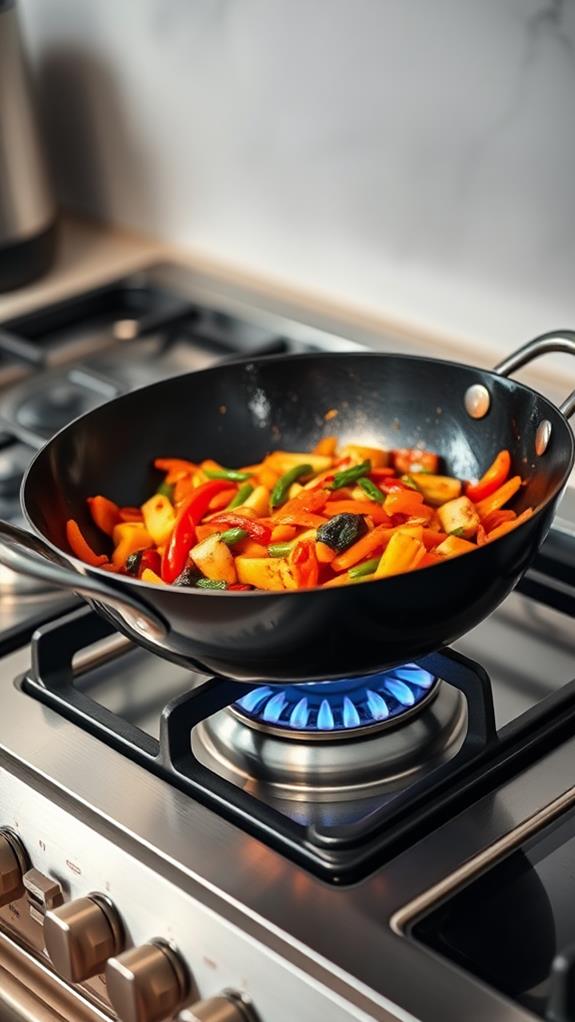
Transforming leftover vegetables into a vibrant stir-fry offers a quick and delicious solution for reducing food waste. This high-heat cooking method is really good at preserving the texture and nutrients of your vegetables while allowing you to customize flavors with various proteins, seasonings, and sauces. Popular herbs like cilantro, basil, and chives can add fresh, zesty flavors to your stir-fry, elevating the dish with minimal effort.
You can easily incorporate a wide range of leftover cooked vegetables into your stir-fry, such as bell peppers, broccoli, mushrooms, snap peas, and bok choy. To create a complete meal, simply toss your stir-fried veggies with cooked rice, noodles, or quinoa. This versatile dish is perfect for using up an assortment of leftover vegetables you might have in your fridge.
Don't worry if you make too much stir-fry – it's incredibly adaptable. You can repurpose your leftover stir-fry in other dishes like fried rice, lettuce wraps, or as a topping for baked potatoes or grain bowls. By mastering the art of stir-frying, you'll have a go-to method for transforming your leftover vegetables into exciting, flavorful meals that reduce waste and tantalize your taste buds.
Frittata and Quiche Magic

You'll find that frittatas and quiches are the perfect canvas for your leftover vegetables, offering endless combinations to suit your taste. These versatile dishes can accommodate a wide range of produce, from leafy greens to roasted root vegetables, making them an excellent choice for reducing food waste. By preparing a frittata or quiche in advance, you'll have a convenient and delicious meal ready to go, saving you time and effort during busy weeknights.
Versatile Veggie Combinations
Frittatas and quiches are two of the most versatile dishes for using up leftover vegetables. They're easy to make and provide a great way to use a lot of leftover veg in one go. You can mix and match almost any combination of vegetables you have on hand, creating unique and flavorful meals each time.
For a balanced frittata or quiche, combine vegetables with different textures and flavors. Pair leafy greens like spinach or kale with firmer vegetables such as bell peppers or zucchini. Root vegetables like carrots or sweet potatoes add a touch of sweetness, while onions and garlic provide depth. Don't forget to include protein sources like cheese, eggs, or tofu to round out the dish.
Some winning combinations include:
- Broccoli, cheddar, and caramelized onions
- Spinach, feta, and sun-dried tomatoes
- Asparagus, mushroom, and gruyere
- Bell peppers, corn, and jalapeños for a southwestern twist
Remember to pre-cook tougher vegetables before adding them to your frittata or quiche to guarantee they're tender and flavorful in the final dish.
Easy Meal Prep
A key advantage of frittatas and quiches is their potential for easy meal prep. You can whip up these versatile dishes in advance, using leftover vegetables from your fridge. By doing so, you're not only reducing food waste but also creating delicious, ready-to-eat meals for the week ahead.
To optimize your meal prep experience, consider using a device to enhance site navigation when searching for recipe ideas online. Many cooking websites use cookies on your device to remember your preferences and provide personalized suggestions. The storing of cookies can improve your browsing experience, making it easier to find new and exciting frittata or quiche combinations.
When preparing these egg-based dishes, you have the freedom to customize them according to your taste and available ingredients. Leftover roasted bell peppers, sautéed mushrooms, or raw broccoli can all find a new purpose in your frittata or quiche. Once cooked, these dishes can be easily reheated for quick breakfasts, lunches, or dinners throughout the week. This approach to meal prep not only saves time but also guarantees you're making the most of your leftover produce, transforming them into nutritious and satisfying meals.
Roasted Veggie Medley
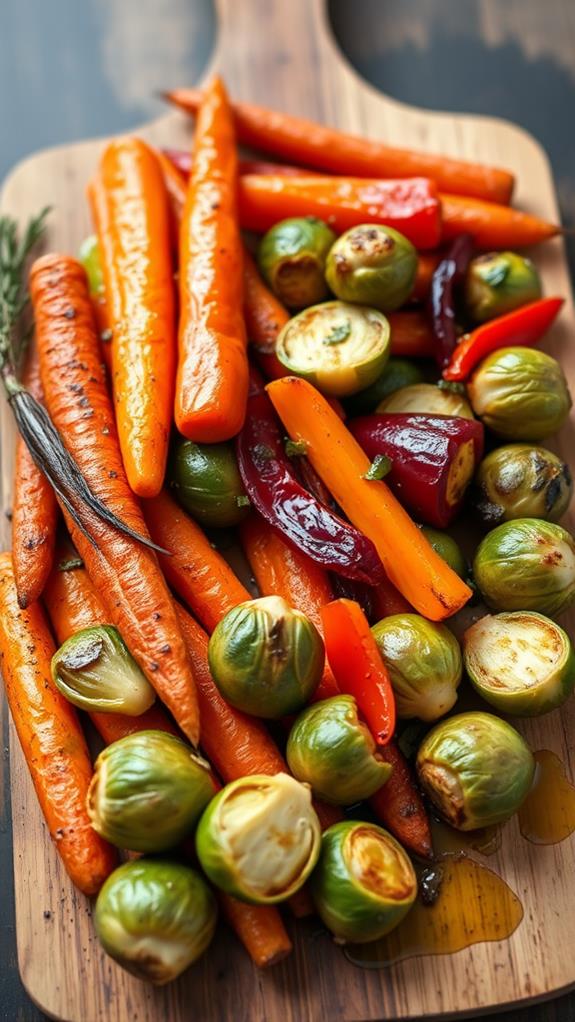
One of the easiest and most delicious ways to use up leftover vegetables is by creating a roasted veggie medley. This versatile dish allows you to combine various vegetables, such as sweet potatoes, Brussels sprouts, and butternut squash, into a flavorful and nutritious meal. To make a roasted veggie medley, simply chop your leftover vegetables into bite-sized pieces, toss them with olive oil and seasonings, and roast them in the oven until they're tender and caramelized.
Here's a simple process to follow:
- Preheat your oven to 425°F (218°C)
- Chop vegetables into uniform sizes for even cooking
- Toss with oil, salt, pepper, and your favorite herbs or spices
You can also add roast potatoes to the mix for extra heartiness. The key to a successful roasted veggie medley is ensuring all vegetables are cut to similar sizes, allowing them to cook evenly. This method not only helps you reduce food waste but also creates a delicious side dish or main course that's packed with nutrients and flavor. Plus, it's an excellent way to meal prep for the week ahead.
Pasta and Risotto Creations
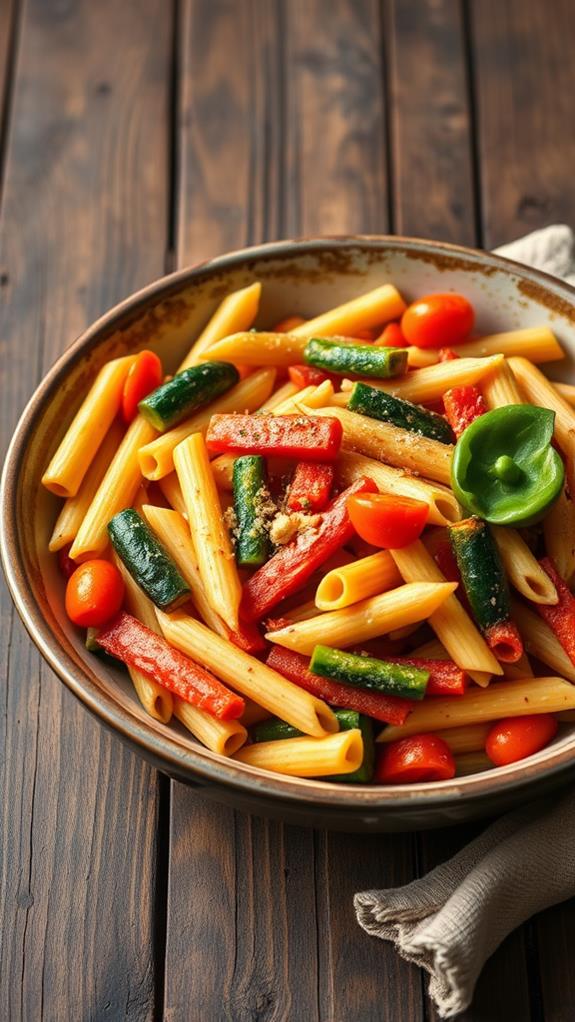
You'll find that leftover vegetables are perfect for creating flavorful pasta dishes and risottos. By tossing cooked veggies with pasta and your favorite sauce, you can easily whip up a nutritious meal that's both satisfying and colorful. For a creamy alternative, try incorporating diced or puréed vegetables into risotto, which will add texture and depth to this classic Italian dish.
Veggie-Packed Pasta Dishes
Transforming leftover vegetables into delicious pasta dishes is a fantastic way to reduce food waste and create satisfying meals. You can easily incorporate a variety of vegetables into your pasta creations, from summer squash to bell peppers. Don't limit yourself to what's in your fridge; a quick trip to the grocery store can provide additional options to complement your leftovers.
To create veggie-packed pasta dishes, try these techniques:
- Sauté diced vegetables like carrots, zucchini, and spinach before tossing them with cooked pasta.
- Add roasted or grilled vegetables to pasta salads for a flavorful twist.
- Blend leftover cooked veggies into the sauce for added nutrition and to use up ingredients.
For a quick and balanced meal, toss hot cooked pasta with sautéed kale, cherry tomatoes, and white beans. This combination provides a variety of textures and flavors while incorporating your leftover vegetables. Remember, you're not limited to traditional pasta dishes; you can also stir cooked broccoli, peas, and tomatoes into a creamy risotto for a well-rounded, veggie-packed alternative. These methods will help you create delicious meals while reducing food waste.
Colorful Risotto Variations
Colorful risotto variations offer another exciting way to repurpose your leftover vegetables while creating a comforting and visually appealing meal. You can make a delicious risotto by sautéing your leftover veggies in olive oil and adding them to the rice along with broth and Parmesan cheese. This method not only reduces food waste but also boosts the nutritional value of your dish.
To create a vibrant and flavorful risotto, consider the following combinations:
| Vegetable Mix | Flavor Enhancers | Protein Addition |
|---|---|---|
| Asparagus & Peas | Lemon zest | Grilled shrimp |
| Roasted peppers & zucchini | Saffron | Diced chicken |
| Mushrooms & spinach | Truffle oil | Crispy pancetta |
Remember to season your risotto with salt and pepper to taste. For added richness, stir in a couple of heaped tablespoons of butter or cream cheese at the end. While risotto is known for its creamy texture, the addition of vegetables increases its fiber content and overall nutritional value. Keep in mind that the nutritional information will vary depending on the vegetables and additional ingredients you choose to incorporate.
Bubble and Squeak Surprise

After a hearty Sunday roast, transform your leftover vegetables into a delicious Bubble and Squeak Surprise. This classic British dish is a great way to reduce food waste and create a tasty meal. To make it, you'll need mashed potatoes, cooked vegetables, and a bit of oil or butter.
Always try to analyze site usage when sharing recipes online, as this can assist in our marketing efforts. However, keep in mind that some recipes may take longer to gain traction. For Bubble and Squeak, follow these steps:
- Mash your leftover vegetables together with the potatoes.
- Form the mixture into patties and chill for 30 minutes.
- Fry the patties in a hot pan until golden and crispy on both sides.
You can customize your Bubble and Squeak by adding different vegetables or herbs. It's a versatile dish that works well for breakfast, lunch, or dinner. Serve it with a fried egg on top for extra protein, or pair it with baked beans for a hearty meal. Don't be afraid to experiment with flavors and textures to create your own unique version of this classic leftover dish.
Veggie Fritters Extravaganza
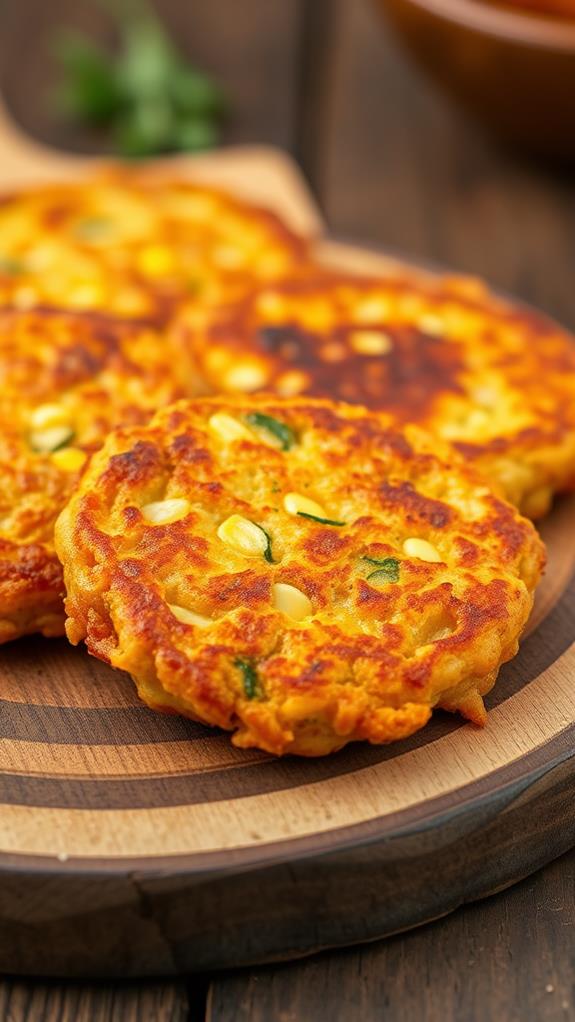
Another fantastic way to repurpose your leftover vegetables is by creating a Veggie Fritters Extravaganza. You'll love how quickly you can whip up these tasty treats, taking just 15 minutes to prepare the first batch. Root vegetables are perfect for fritters, as they mash easily, but don't hesitate to throw in leftover Brussels sprouts or other greens for added texture and nutrition.
To enhance the flavor profile, try incorporating curry powder or other spices. You'll find that combining different types of vegetables creates interesting textures and tastes. As part of the Dotdash Meredith family of websites, we agree to the storing of cookies on your device. By clicking Accept All Cookies, you're allowing us to analyze site usage and improve your browsing experience.
These fritters aren't just delicious; they're also a healthier alternative to fried foods when prepared with nutrient-dense vegetables. They're packed with essential vitamins, minerals, and dietary fiber. Best of all, you can freeze any leftover fritters for easy storage and reheating later. Remember, you can always adjust your cookie preferences in the Settings Accept All Cookies menu.
Frequently Asked Questions
What to Do With Excess Vegetables?
You've got excess vegetables? Don't let them go to waste! Consider freezing them for future use in soups or stir-fries. Alternatively, create a hearty vegetable stock by simmering them with herbs and spices. You can also pickle or ferment your veggies, extending their shelf life and adding flavor to meals. Another option is to blend them into smoothies or puree them for sauces. If you're feeling creative, try dehydrating them for healthy snacks or incorporating them into baked goods like muffins or bread.
What Can I Do With Leftover Vegetable Scraps?
You've got several options for those leftover vegetable scraps. You can create a flavorful vegetable stock by simmering them with water, herbs, and spices. Composting is another great choice, turning scraps into nutrient-rich soil for your plants. Try dehydrating them to make vegetable chips or powders for seasoning. Pickling scraps in vinegar, salt, and spices creates a tasty condiment. Finally, blend them into smoothies or soups to maximize their nutritional value and reduce waste.
What Can I Do With Too Many Fresh Vegetables?
If you've got too many fresh vegetables, don't let them go to waste. You can pickle them to extend their shelf life up to a month. Try incorporating them into fritters, fried rice, or stir-fries. Roast a mix of veggies for a versatile side dish or salad addition. Blend them into smoothies or puree for soups. If you can't use them soon, freeze cooked veggies for later use in casseroles or as quick sides. These methods help you maximize your produce and minimize waste.
How Do You Eat Leftover Vegetables?
Did you know that the average American household wastes about 31.9% of the food it buys? To combat this, you can easily eat leftover vegetables in various ways. You'll find that incorporating them into frittatas or quiches is a delicious option. Alternatively, you can sauté or roast them and toss with pasta or grains. Blending them into soups or stews works well too. Don't forget, you can also pickle them or use them as toppings for pizzas and sandwiches.





